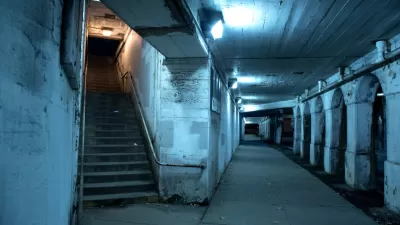Drawing heavily on comparisons to the booms and busts of American cities, a writer describes the perfectly-preserved, abandoned, virtual cities of the popular online game World of Warcraft.
"America has seen plenty of cities rapidly grow and fade. From the boom towns of the Gold Rush to Detroit’s rise and fall alongside the country’s auto industry, the narrative is the same: People are drawn where they think they can make their fortune. When the money and jobs dry up, some stay out of attachment—they want to see their home rise again. And many have nowhere else to go. But on the large scale, populations move to wherever the next city of opportunity happens to be," writes Samantha Nelson.
The process of boom and bust has played out repeatedly in the "massively multiplayer online" game of World of Warcraft. Because of the game's now long history (first launched in 2004, the game has had a number of expansions and new cities added to its online universe), some of the cities created for the game have since been abandoned as the games many players have moved on to new locations to fill new needs and find new adventures.
Nelson, however, likes to visit she describes the experience of wondering the abandoned virtual places in the game as a parallel to experiences of feeling alone in a real city: "In WOW, the context is a quasi-urban one. Playing the game is like being in a city. The first people who moved to cities gave up the self-sufficiency of family farms for the advantages of an urban economy. Likewise, multiplayer games don’t expect you to do everything on your own. Players regularly call on each other for help with quests. They alert friends to the presence of rare monsters. They joke around in the chat. So when you’re alone in WOW, it feels like walking a city’s streets at night. It’s disorienting, isolating, and despite all logic, it can feel a bit unsafe. You’re truly on your own, with no one to give you backup if a fight turns sour."
FULL STORY: There’s hidden beauty in abandoned World Of Warcraft cities

Planetizen Federal Action Tracker
A weekly monitor of how Trump’s orders and actions are impacting planners and planning in America.

Map: Where Senate Republicans Want to Sell Your Public Lands
For public land advocates, the Senate Republicans’ proposal to sell millions of acres of public land in the West is “the biggest fight of their careers.”

Restaurant Patios Were a Pandemic Win — Why Were They so Hard to Keep?
Social distancing requirements and changes in travel patterns prompted cities to pilot new uses for street and sidewalk space. Then it got complicated.

Platform Pilsner: Vancouver Transit Agency Releases... a Beer?
TransLink will receive a portion of every sale of the four-pack.

Toronto Weighs Cheaper Transit, Parking Hikes for Major Events
Special event rates would take effect during large festivals, sports games and concerts to ‘discourage driving, manage congestion and free up space for transit.”

Berlin to Consider Car-Free Zone Larger Than Manhattan
The area bound by the 22-mile Ringbahn would still allow 12 uses of a private automobile per year per person, and several other exemptions.
Urban Design for Planners 1: Software Tools
This six-course series explores essential urban design concepts using open source software and equips planners with the tools they need to participate fully in the urban design process.
Planning for Universal Design
Learn the tools for implementing Universal Design in planning regulations.
Heyer Gruel & Associates PA
JM Goldson LLC
Custer County Colorado
City of Camden Redevelopment Agency
City of Astoria
Transportation Research & Education Center (TREC) at Portland State University
Camden Redevelopment Agency
City of Claremont
Municipality of Princeton (NJ)



























